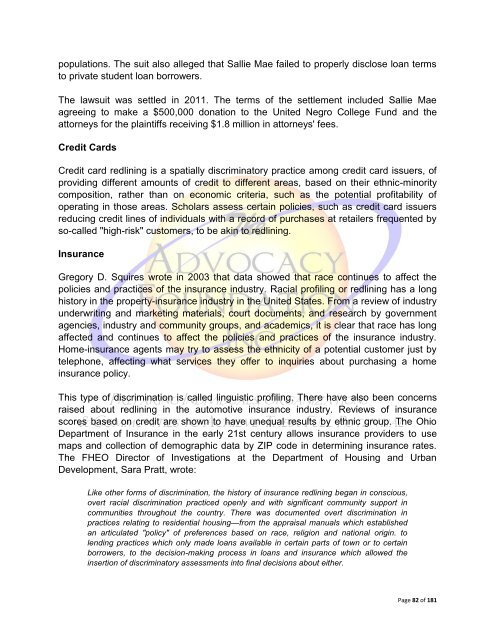You also want an ePaper? Increase the reach of your titles
YUMPU automatically turns print PDFs into web optimized ePapers that Google loves.
populations. The suit also alleged that Sallie Mae failed to properly disclose loan terms<br />
to private student loan borrowers.<br />
The lawsuit was settled in 2011. The terms of the settlement included Sallie Mae<br />
agreeing to make a $500,000 donation to the United Negro College Fund and the<br />
attorneys for the plaintiffs receiving $1.8 million in attorneys' fees.<br />
Credit Cards<br />
Credit card redlining is a spatially discriminatory practice among credit card issuers, of<br />
providing different amounts of credit to different areas, based on their ethnic-minority<br />
composition, rather than on economic criteria, such as the potential profitability of<br />
operating in those areas. Scholars assess certain policies, such as credit card issuers<br />
reducing credit lines of individuals with a record of purchases at retailers frequented by<br />
so-called "high-risk" customers, to be akin to redlining.<br />
Insurance<br />
Gregory D. Squires wrote in 2003 that data showed that race continues to affect the<br />
policies and practices of the insurance industry. Racial profiling or redlining has a long<br />
history in the property-insurance industry in the United States. From a review of industry<br />
underwriting and marketing materials, court documents, and research by government<br />
agencies, industry and community groups, and academics, it is clear that race has long<br />
affected and continues to affect the policies and practices of the insurance industry.<br />
Home-insurance agents may try to assess the ethnicity of a potential customer just by<br />
telephone, affecting what services they offer to inquiries about purchasing a home<br />
insurance policy.<br />
This type of discrimination is called linguistic profiling. There have also been concerns<br />
raised about redlining in the automotive insurance industry. Reviews of insurance<br />
scores based on credit are shown to have unequal results by ethnic group. The Ohio<br />
Department of Insurance in the early 21st century allows insurance providers to use<br />
maps and collection of demographic data by ZIP code in determining insurance rates.<br />
The FHEO Director of Investigations at the Department of Housing and Urban<br />
Development, Sara Pratt, wrote:<br />
Like other forms of discrimination, the history of insurance redlining began in conscious,<br />
overt racial discrimination practiced openly and with significant community support in<br />
communities throughout the country. There was documented overt discrimination in<br />
practices relating to residential housing—from the appraisal manuals which established<br />
an articulated "policy" of preferences based on race, religion and national origin. to<br />
lending practices which only made loans available in certain parts of town or to certain<br />
borrowers, to the decision-making process in loans and insurance which allowed the<br />
insertion of discriminatory assessments into final decisions about either.<br />
Page 82 of 181

















